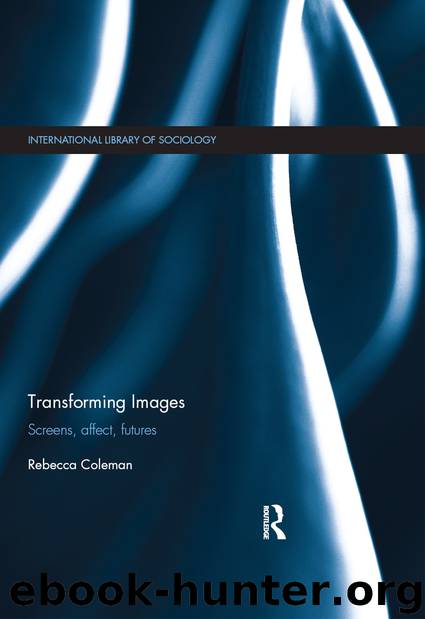Transforming Images by Coleman Rebecca

Author:Coleman, Rebecca
Language: eng
Format: epub
ISBN: 978-1-317-57145-2
Publisher: Taylor and Francis
Becoming better: television, affect, power
As I have discussed, ‘the affective turn’ in social and cultural theory is interested in a varied set of ideas and processes, some of which have been taken up in recent accounts of makeover television, and some of which I have been working through here. The first assertion made in the turn to affect that I am interested in takes up the emphasis on relationality and process in its understanding of contemporary social and cultural life as characterized by ‘aliveness and vitality’ (Clough 2007: 2), as ‘changed and changing’ and as ‘exceed[ing] all efforts to contain it’ (2007: 28). In terms of my focus in this chapter then, the images of transformation circulated in makeover television can be understood as affective because they are concerned with change; they are affective in their ‘liveness’ and emphasis on process. While I argue that images of transformation generally are processual and alive, issues of the ‘liveness’, intimacy and proximity seem to be especially significant to television, and to makeover television more specifically. It is the case, therefore, that the affective turn is not only a set of theories that have been applied to shifts in contemporary culture, but is also a series of current ‘happenings’ that have required new theories in order to be more adequately understood.
The second and third concerns of the affective turn that I identified regard the shift from conceiving bodies as entities to processes – bodies are in continuous process and change – and a re-working of images and representational thinking. In this chapter, I have explored the ways in which makeover television programmes engage the body as process through the affectivity of images. However, it is also worth returning to Clough’s argument that I discussed in Chapter 1 in order to develop further my focus on the screen. That is, as a flat surface, how is the screen involved in organizing the affectivity of images? It is helpful to take up Clough’s analysis of the way in which the textual turn in the 1970s and 1980s rendered media and culture as ‘flat’ texts. Here, the notion of flatness refers both to the waning of affect in postmodern culture – namely, that culture becomes so integrated into capitalist production that it is no longer affectively or intellectually meaningful – and to the ways in which media and culture were read as a series of inter-linked texts. One way in which such an understanding of flatness could be developed in terms of the contemporary ‘society of the screen’ (Manovich 2002) would be to argue that as screens come to dominate socio-cultural life, as we come to access more and more of our information and images via screens, culture has become both textual and immaterial; culture has lost its materiality, its sensuousness, its profundity and its depth. In contrast to this conception of the implications of the flatness of the screen, what I have aimed to demonstrate in this chapter is that for working-class women, the screen
Download
This site does not store any files on its server. We only index and link to content provided by other sites. Please contact the content providers to delete copyright contents if any and email us, we'll remove relevant links or contents immediately.
| Coloring Books for Grown-Ups | Humor |
| Movies | Performing Arts |
| Pop Culture | Puzzles & Games |
| Radio | Sheet Music & Scores |
| Television | Trivia & Fun Facts |
The Social Psychology of Inequality by Unknown(2939)
Make Comics Like the Pros by Greg Pak(2852)
Stacked Decks by The Rotenberg Collection(2811)
Purple Hibiscus by Chimamanda Ngozi Adichie(2650)
The Queen of Nothing by Holly Black(2492)
The Art of Doom by Bethesda(2106)
Life of Elizabeth I by Alison Weir(2026)
Putin's Labyrinth(1960)
The Power of Habit: Why We Do What We Do in Life and Business by Charles Duhigg(1940)
Drawing Down the Moon by Margot Adler(1824)
Things Are What You Make of Them: Life Advice for Creatives by Adam J. Kurtz(1817)
Wall and Piece by Banksy(1781)
Agency by William Gibson(1778)
Art Of Atari by Tim Lapetino(1750)
Teaching to Transgress: Education as the Practice of Freedom (Harvest in Translation) by Bell Hooks(1694)
The Beatles Lyrics by Hunter Davies(1672)
The Pin-Up Art of Bill Ward by Bill Ward(1651)
Only What's Necessary: Charles M. Schulz and the Art of Peanuts by Chip Kidd(1645)
The Andy Warhol Diaries by Andy Warhol(1561)
